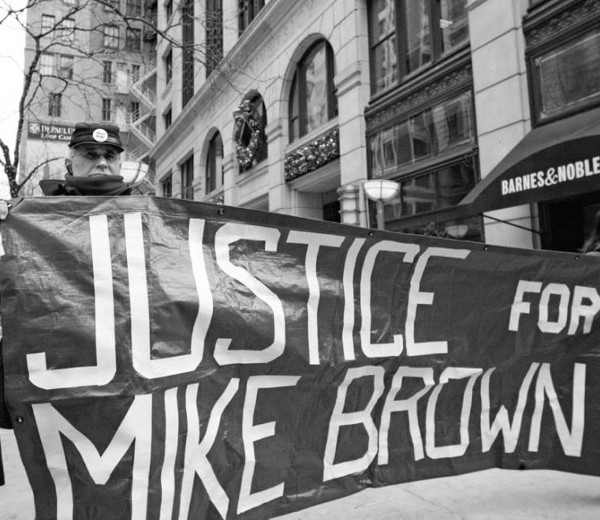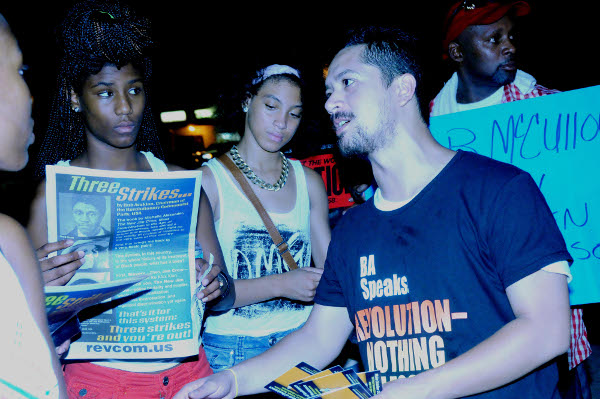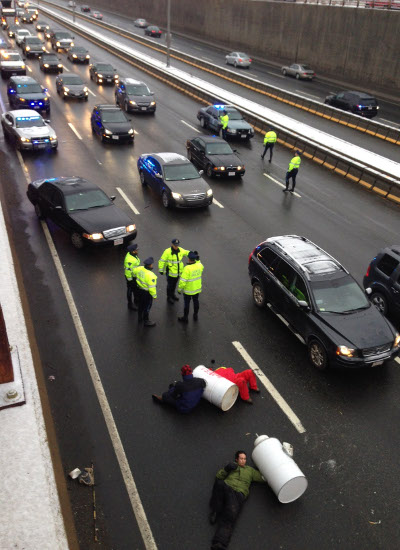The Unjust Repression Against Protesters Fighting for Justice
February 2, 2015 | Revolution Newspaper | revcom.us
It is a huge injustice that while the cops who killed Michael Brown, Eric Garner, Tamir Rice, and others walk free, those who are stepping out—acting on their outrage and conscience, and protesting these police murders—are under heavy attack from the powers-that-be. Ferguson, Missouri was put under a State of Emergency declaration days before the grand jury announced they were not indicting the cop who killed Michael Brown. In cities across the country, police have made mass arrests and violently attacked protesters. Prosecutors are bringing heavy charges against some protesters. Revolutionaries are being singled out for persecution. Police have released videos, photos, and addresses of people for alleged crimes related to the protests, and these have been broadcast in the media, in attempts to sow divisions among protesters and to send a message broadly that protesters better “behave” (or even not protest at all).
In this article, we point to some recent examples of how this repression against the protests is going down. But more needs to be learned and understood about this repression. What is going on in different cities? What are the patterns and trends? How are different sections of the people and different groups and organizations responding? We call on readers to send reports on attacks on the movement to revolution.reports@yahoo.com
These attacks are part of a counteroffensive by the powers-that-be to suppress and kill the massive and inspiring movement that rose up, first in Ferguson and then across the country, as people stepped out into the streets in thousands and tens of thousands and acted in many different ways to stand up and speak out against the intolerable oppression of Black people and the brutal police that enforce that injustice. Meanwhile, the outrage of police murder and brutality, especially against people of color—and the official sanctioning of those crimes—continues. As we have said, there is a huge challenge before the people right now “to go back on the offensive and bring forward even more massive waves of struggle to STOP these outrages. Not mitigate them, not tone them down—but STOP them.” (See “The Cold but Liberating Truth About the Police, the Struggle for Justice, and Revolution“)
Fighting against the repressive attacks on the protests is crucial to going back on the offensive. When brave freedom fighters are targeted and hit with serious charges, they need to be upheld and defended, in the courtroom and widely in society, as part of drawing forward even more people into the movement of resistance. When the police, government officials, and the media use threats and lies to try to intimidate and silence protests, it needs to be exposed and opposed. When entertainers, artists, and others in the public eye are retaliated against for speaking out about “Black lives matter,” people need to have their backs.
****
Ferguson: Using Surveillance Video to Target People
In mid-January, the St. Louis County police began releasing surveillance videos and photos that they claimed showed stores being looted during the protests that broke out after the announcement that the grand jury had decided not to indict the cop who killed Michael Brown. The police said they were going to track down and arrest the alleged looters—and called on the public to help identify the people in the videos and photos. The videos and photos, and the police call for people to become informants, were broadcast widely in the media. The St. Louis County police said they will be releasing more such videos and photos every week, showing hundreds of “suspects.”
Let’s be clear: This has nothing to do with righting wrongs. It’s about the powers-that-be trying to divert attention and anger away from the real outrage of the cold-blooded murder of a Black youth—and the official green light given to this crime. The police have created further “justification” to go after people in the oppressed communities in Ferguson and nearby areas, where they already act as an occupying army. In a situation where many people are already caught up in the web of mass incarceration and may have a “record,” another arrest may mean heavy charges and long prison sentences. The broadcasting of the “Wanted” videos and photos is also a means of training people to think—falsely—that they have a common interest with the police. And it is meant as a message that people had better stay within officially sanctioned boundaries of protest—because the eyes of the police will be on those who don’t.
This move by the St. Louis County police is similar to the way the New York Police Department released “Wanted” pictures of people accused of trying to free a protester from the clutches of cops during a march across the Brooklyn Bridge in December, and how this was blasted out on the front pages of the tabloid papers. (See “The NYPD and the Whole Damn System Are Guilty—Not Protesters!“) The police in Seattle also posted pictures of two people they said were wanted for allegedly trying to prevent another protester from being arrested.
Persecution of Chicago Activists
There are a couple of very important cases in Chicago of people facing heavy charges for taking part in protest.

Grant Newburger shortly before his arrest at the November 23, 2014, protest in Chicago.
On November 23, Grant Newburger—who is well known and respected in the South and West Side neighborhoods of Chicago for bringing the revolution to people and helping to form the Revolution Club of Chicago—was charged with felony aggravated assault on a cop, simply for carrying, with two other people, a banner saying “Justice for Mike Brown” into a downtown street on a green light during a protest march. Grant was deliberately assaulted by cops on bicycles; the cops knocked him to the ground. There were no injuries to the cops. In an article on the protest, the Chicago Tribune printed a picture of Grant’s face and the location of the block where they say he lives—a dangerous move given how the police retaliate against those who oppose and expose them, and also in the context of fascistic forces making threats against revolutionaries.
This was a total outrage in itself—but then, at a December 17 court hearing, the prosecutor added two more counts of felony assault on a cop for the same incident! These charges carry a possible total 21-year prison sentence. (For more on Grant Newburger’s case, see the leaflet from the Chicago Revolution Club.)
On December 13, at a march of hundreds in the heart of Chicago’s upscale shopping district, 23 people were arrested. Just stepping off the sidewalk would result in an arrest. Particularly vicious was the arrest of a member of the Revolution Club, “Iggy,” a young Black revolutionary and street musician from the South Side. He was among the protesters outside the Nordstrom store, where others were staging a die-in. The police attacked the protesters outside, hitting people and knocking them to the ground. Iggy sustained facial injuries—yet he was the one charged with felonious assault on a cop. Another protester, Alfredo, was also arrested and charged with a felony during the same police riot. At the same time, a young woman from the Revolution Club was singled out for arrest and charged with misdemeanors.
At the December 14 court hearing, Iggy and Alfredo were given $75,000 bail each—very high for first-time offenders with jobs and ties to the community. As in the case with Grant Newburger, the Chicago Tribune ran an article with both mens’ mug shots and the location of the blocks where they say they live. (See “Chicago: Oppose the Vicious and Outrageous Charges Against Those Who Protested Police Murder!“)
Noche Diaz, New York Revolution Club: Assaulted by Police, Threatened, and Facing Multiple Charges for Leading Resistance

Noche Diaz in Ferguson, Missouri. Photo: Special to revcom.us
Noche Diaz is well recognized by friends, as well as foes, as a leader of the NYC Revolution Club, and for being on the front lines of the battle against police murder and brutality. After the murder of Michael Brown and after the announcement of the grand jury decision to let the murdering cop free, Noche was singled out in protests by the NYPD—threatened, assaulted, and arrested. As Noche describes it, at the November 25 march, the cops were saying things to him like, “I know you, you already have a case, you better go home, cuz when we get you, you ain’t going nowhere for a long time, we’re gonna put you away.” Other people in the march could hear the police threats and, Noche points out, “It was clear to a lot of people they had my number, so to speak.” A police supervisor had grabbed him by the throat during a protest the previous night. And when the cops grabbed Noche during the November 25 protest, they slammed him to the ground and took him behind the police line, where one said, “Let’s take him behind the truck where no one can see.”
Noche is now facing multiple charges and, if convicted, could receive a two-year sentence. His trial is scheduled for March 19. (For more on Noche’s case, see “New Developments in the Persecution of Noche Diaz of the NYC Revolution Club.)
Boston: 29 Arrested in Bold Interstate Shutdown

Protesters stop morning commute traffic on an interstate near Boston, December 15, 2014.
AP photo
On December 15, protesters courageously stepped onto Interstate 93. The protest organizers intended to “disrupt business as usual”—and they shut down traffic in and out of Boston at the height of the morning commute. Some protesters attached themselves to 1,200-pound barrels filled with concrete. Others had signs with slogans like “End White Supremacy.” One of the protesters said, “We must remember, Ferguson is not a faraway Southern city. Black men, women, and gender-nonconforming people face disproportionately higher risk of profiling, unjust incarceration, and death. Police violence is everywhere in the United States.”
Twenty-nine people were arrested in the action—most were charged with disorderly conduct, trespass, and resisting arrest, while several people were charged with conspiracy and “carrying a dangerous weapon.”
Courageous Action by Stanford Students in the Face of Mass Arrests
On January 19, as the annual MLK Day was marked by different events across the country, a new spirit of resistance was evident as people defiantly took to the streets in determined resistance against police murder and brutality. (See revcom.us coverage of those protests here.)
One of the notable actions was the shutting down of the nine-mile-long San Mateo Bridge over San Francisco Bay by Stanford University students and others. The protesters said they were blocking the traffic on the busy bridge for 28 minutes to symbolize the fact that a Black person in the U.S. is killed by police or vigilantes every 28 hours. Silicon Valley Shutdown, a collective of students, said that the action was “in defense of all Black lives. We stand with Black men and women. We act when Black Queer and Trans lives are threatened. We defend the rights of our Black family when we are poor, disabled and incarcerated.”
According to the Stanford Daily, 68 people were arrested at the action—and the county DA is considering what charges to file against them.
Volunteers Needed... for revcom.us and Revolution
If you like this article, subscribe, donate to and sustain Revolution newspaper.
